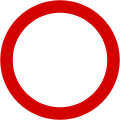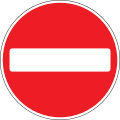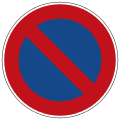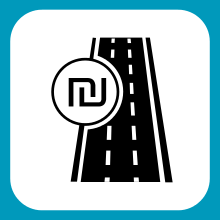Road signs in Israel

Road signs in Israel are decided by the Ministry of Transportation in the Division of Transportation Planning, most recently set forth in June 2011.[1]
They generally use the same pattern of colours, shapes, and symbols as used in most countries of Europe and the Middle East and set out in the Vienna Convention on Road Signs and Signals.
Language
Signs employ three scripts – Hebrew, Arabic, and Latin – and are written in Hebrew and Arabic, the two official languages of the country, and in English. However, signs in Arabic and English are often spelt wrong.[2]
The stop sign, however, instead of displaying words in three languages, conveys its meaning through the depiction of a raised hand.
Signs giving warnings
Signs warning of hazardous conditions or dangerous situations (e.g. "Intersection" or "Steep incline ahead" bear a black-on-white symbol inside a red-bordered triangle (point uppermost).
- Signs giving warnings
-
.svg.png)
Stop sign ahead
-
.png)
Bumpy road
-
.png)
Sharp left curve
-
.png)
Sharp right curve
-
.png)
Winding left curve
-
.png)
Winding right curve
-
.png)
Curve left and then right
-
.png)
Curve right and then left
-
.png)
Winding road ahead
-
.png)
Road narrows ahead
-

Narrow bridge warning
-
.png)
Roadworks
-

Intersection ahead
-

Side road on the left ahead
-

Side road on the right ahead
-
.png)
T-intersection
-

Staggered crossroads
-

Roundabout ahead
-

Minor road merging from the right
-

Merge with major road from the left
-

Minor road merging from the left
-

Merge with major road from the right
-
.png)
Traffic congestion
-
.png)
Rock slide zone
-
.png)
Dangerous descent
-
.png)
Danger of skidding
-

Pedestrian crossing
-

Pedestrians nearby
-
.png)
Two-way traffic
-

Speed bump
-
.png)
Wild animals
-
.svg.png)
Farm vehicles crossing
-
.png)
Bicycle traffic crossing
Signs giving orders
With the exception of the special shapes used for "Stop" and "Yield" signs (respectively, an octagon and a downward-pointing triangle), signs giving orders are circular and are of two kinds:
- Prohibitory signs (e.g. "No left turn") take the form of a black-on-white symbol inside a red-bordered circle, sometimes with the addition of a red slash through the symbol.
- Mandatory signs (e.g. "Turn right only") bear a white symbol on a blue disk.
- Signs giving orders
-

Stop
-

Yield
-

Closed to all vehicles
-

No entry
-

No left turn ahead
-

No right turn ahead
-

No U-turns
-
.png)
Cars prohibited
-

Customs
-

Speed limit (50 km/h)
-

Do not use horn
-

No parking
-

Tractors and work vehicles prohibited
-
.png)
Bicycles prohibited
-

Pedestrians prohibited
-
.png)
Bicycle path only
-

Pedestrian and bicycle path only
Signs giving information
Signs giving information are generally rectangular (sometimes pointed at one end in the case of direction signage).
Highways in Israel are classified as national (single-digit number), inter-city (two digits), regional (three digits), or local (four digits), and route-marker signs are also colour-coded (respectively: blue, red, green, and brown) according to these classes.
Most directional signs to towns and cities are white-on-blue (motorways), white-on-green (other main roads), black-on-white (local destinations), or white-on-brown (tourist destinations: landmarks, historical sites, nature reserves, etc.).
The sign for permitted parking features a white-on-blue "P" for "parking" enclosed by the Hebrew letter Het ("ח") for "hanaya" (Hebrew: חניה), which also means "parking").
The sign informing users that they are on a priority road is a white-edged yellow "diamond" (i.e. a square turned through 45°).
- Information signs
-

National roads (Highway)
-

Inter-City roads (Highway)
-

Regional roads (Route)
-

Local roads (Road)
-

Direction sign
-

Tourist destination sign
-

Tel Aviv street sign
-

Major road sign
-

Parking (sign can be two-sided)
-
.png)
Handicap parking
-

Entry to motorway
-

Entry to toll road (with Israel Shekel symbol)
-

Priority road (you have right of way)
References
- ↑ Traffic Sign Sheet, Ministry of Transportation, July 2012
- ↑ http://www.economist.com/news/middle-east-and-africa/21594353-avigdor-liebermans-radical-ideas-population-transfers-are-gaining-ground-might An Arab-Israeli dilemma: Might they want to join Palestine?
| Wikimedia Commons has media related to Road signs in Israel. |